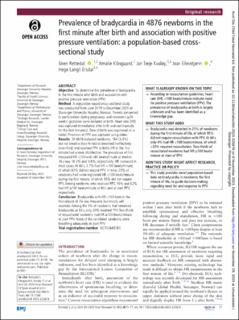| dc.contributor.author | Rettedal, Siren | |
| dc.contributor.author | Kibsgaard-Petersen, Amalie | |
| dc.contributor.author | Kvaløy, Jan Terje | |
| dc.contributor.author | Eilevstjønn, Joar | |
| dc.contributor.author | Ersdal, Hege Langli | |
| dc.date.accessioned | 2023-12-01T07:11:40Z | |
| dc.date.available | 2023-12-01T07:11:40Z | |
| dc.date.created | 2023-11-29T12:22:01Z | |
| dc.date.issued | 2023 | |
| dc.identifier.citation | Rettedal, S., Kibsgaard, A., Kvaløy, J. T., Eilevstjønn, J., & Ersdal, H. L. (2023). Prevalence of bradycardia in 4876 newborns in the first minute after birth and association with positive pressure ventilation: a population-based cross-sectional study. Archives of Disease in Childhood-Fetal and Neonatal Edition. | en_US |
| dc.identifier.issn | 1359-2998 | |
| dc.identifier.uri | https://hdl.handle.net/11250/3105510 | |
| dc.description.abstract | Objective To determine the prevalence of bradycardia in the first minute after birth and association with positive pressure ventilation (PPV).
Method A population-based cross-sectional study was conducted from June 2019 to December 2021 at Stavanger University Hospital, Norway. Parents consented to participation during pregnancy, and newborns ≥28 weeks’ gestation were included at birth. Heart rate (HR) was captured immediately after birth and continuously for the first minute(s). Time of birth was registered on a tablet. Provision of PPV was captured using video.
Results Of 4876 included newborns, 164 (3.4%) did not breathe (two-thirds) or breathed ineffectively (one-third) and received PPV at birth. HR in the first minute had a wide distribution. The prevalence of first measured HR <100 and <60 beats/minute at median 16 s was 16.3% and 0.6%, respectively. HR increased in most cases. At 60 s, 3.7% had HR <100 beats/minute, of which 82% did not require PPV. In total, 25% of newborns had some registered HR <100 beats/minute during the first minute, of which 95% did not require PPV. Among newborns who received PPV, 76% and 62% had HR ≥100 beats/minute at 60 s and at start PPV, respectively.
Conclusion Bradycardia with HR <100 bpm in the first minute of life was frequent, but mostly self-resolved. Among the 4% of newborns that remained bradycardic at 60 s, only 20% received PPV. Two-thirds of resuscitated newborns had HR ≥100 beats/minute at start PPV. None of the ventilated newborns were breathing adequately at start PPV. | en_US |
| dc.language.iso | eng | en_US |
| dc.publisher | BMJ Publishing Group | en_US |
| dc.rights | Navngivelse 4.0 Internasjonal | * |
| dc.rights.uri | http://creativecommons.org/licenses/by/4.0/deed.no | * |
| dc.title | Prevalence of bradycardia in 4876 newborns in the first minute after birth and association with positive pressure ventilation: A population-based cross-sectional study | en_US |
| dc.type | Peer reviewed | en_US |
| dc.type | Journal article | en_US |
| dc.description.version | publishedVersion | en_US |
| dc.rights.holder | © The Author(s) 2023 | en_US |
| dc.subject.nsi | VDP::Medisinske Fag: 700 | en_US |
| dc.source.journal | Archives of Disease in Childhood: Fetal and Neonatal Edition | en_US |
| dc.identifier.doi | 10.1136/archdischild-2023-325878 | |
| dc.identifier.cristin | 2205088 | |
| cristin.ispublished | true | |
| cristin.fulltext | original | |
| cristin.qualitycode | 2 | |

